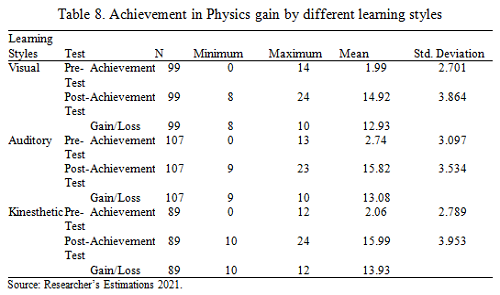
Learning Styles: Tools for Understanding Media Selection and Learners’ Academic Achievement in Physics
Abstract
Keywords
Full Text:
PDFReferences
Akinbobola, A.O. (2015). Effects of learning style and instructional strategies on students’ achievement in Nigerian senior secondary school physics. Advance in Physics Theories and Applications, 41, 20-29.
Ali, M. (2009). Pengembangan media pembelajaran interaktif mata kuliah medan elektromagnetik. Jurnal Edukasi@Elektr, 5(1):2009. http://journal.uny.ac.id/index.php/jee/article/view/348/250.
Al-Zayed, N. N. (2017). An Investigation of Learning Style Preferences on the Students’ Academic Achievements of English. International Journal of English Linguistics 7 (5) 173-183.
Bingimlas, K. (2009). Barriers to the successful integration of ICT in teaching and learning environments: A review of literatures. Eurasian Journal of Mathematics, Science and Technology, 5(3), 120-461.
Bronack (2011). The role of immersive media in online education. The Journal of Continuing Higher Education, 59 (2), 113-117.
Dunn, R. (1990). Understanding the Dunn and Dunn learning style’s model and the need for individual diagnosis and prescription. Reading, writing and learning disabilities, 6, 223-247.
Edorgan, T. (2010). Obstacles in integrating ICT in schools taking into consideration the opinions of primary and secondary schools in Turkey. Journal of Instructional Science and Technology, 51:23-78.
Erica, A. Wehrwein, H. L., Stephen, L and DiCarlo, E. (2007). Advances in Physiology Education. 31 (2), 153-157
Fanuel Wesonga, M.M., & Aurah, C. (2019). Influence of teachers’ instructional strategy and students’ learning styles on academic achievement in Kenyan high school. European Journal of Education Studies, 6(8), 190-202.
Fleming, N. D. (2015). "The VARK modalities". vark-learn.com.. Retrieved 15th February, 2021.
Felder, R.M., & Silverman, L.K. (1988). Learning and teaching styles in engineering education. Eng. Education, 78, 674-681.
Franzoni, A.L. & Assar, S. (2009). Student learning styles adaptation method based on teaching strategies and electronic media. Educational Technology and Society, 12(4),15-29.
Hashim, W.A. & Hashim, H.A. (2015). Selection of appropriate media and technology for distance education. International Journal of Science and Research, 4(11), 1209-1216.
Luvisa, J.C. (2003). Availability of and use of instructional media in teaching Kiswahili in secondary schools in Bungoma district. Unpublished M. Ed Thesis: Moi University.
Murundu, H.H., Okwara, M.O., Otienoh, R. & Murundu, Z.O. (2017). Factors influencing selection and use of media for Christian religious education. Research on Humanities and Social Sciences, 7(8),29-36.
Naqvi, G., & Naqvi, F. (2017). A study on learning styles, gender and academic performance of post graduate management students in India. International Journal Economics Management Science, 6, 398.
Nurseto, T. (2011). Membuat media pembelajaran yang menarik. Journal Ekonomi and Pendidikan, 8(1), 1-8.
Ramdhani, M.A., & Muhammadiyah, H. (2015). The criteria of learning media selection for character education in higher education. Proceeding International Conference of Islamic Education: Reforms, Prospects and Challenges. Faculty of Tarbiyah and Teaching Training, Maulana Malik Ibrahim State Islamic University, Malang.
Rahadian and Budiningshih (2017). What are the suitable instructional strategy and media for student learning styles in middle schools. International Journal on Integrating Technology in Education, 6(4), 25-39.
Riding, R., & Grimley, M. (1998). Cognitive style and learning from multimedia materials in 11-years children. British Journal of Educational Technology, 30(1), 43-59.
Sara, S.S. (2010). Effects of learning styles on career preferences of senior secondary school students in Jigawa State, Nigeria. Edo Journal of Counselling,3(1), 132-143.
Sternburg, R.J. (1990). Thinking styles. Keys to understanding students’ performance. Phi Delta Kappan,71(5),366-371.
Yakasai, M.I. (1991) Relationship of cognitive style to child learning practices among urban and rural Hausa students. Unpublished M.Ed. Thesis, Bayero University, Kano
DOI: http://dx.doi.org/10.31258/jes.5.4.p.584-597
Refbacks
- There are currently no refbacks.
Copyright (c) 2021 Folashade Afolabi

This work is licensed under a Creative Commons Attribution 4.0 International License.
Publisher: FKIP Universitas Riau













